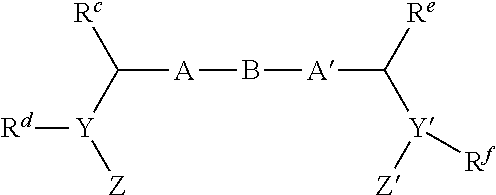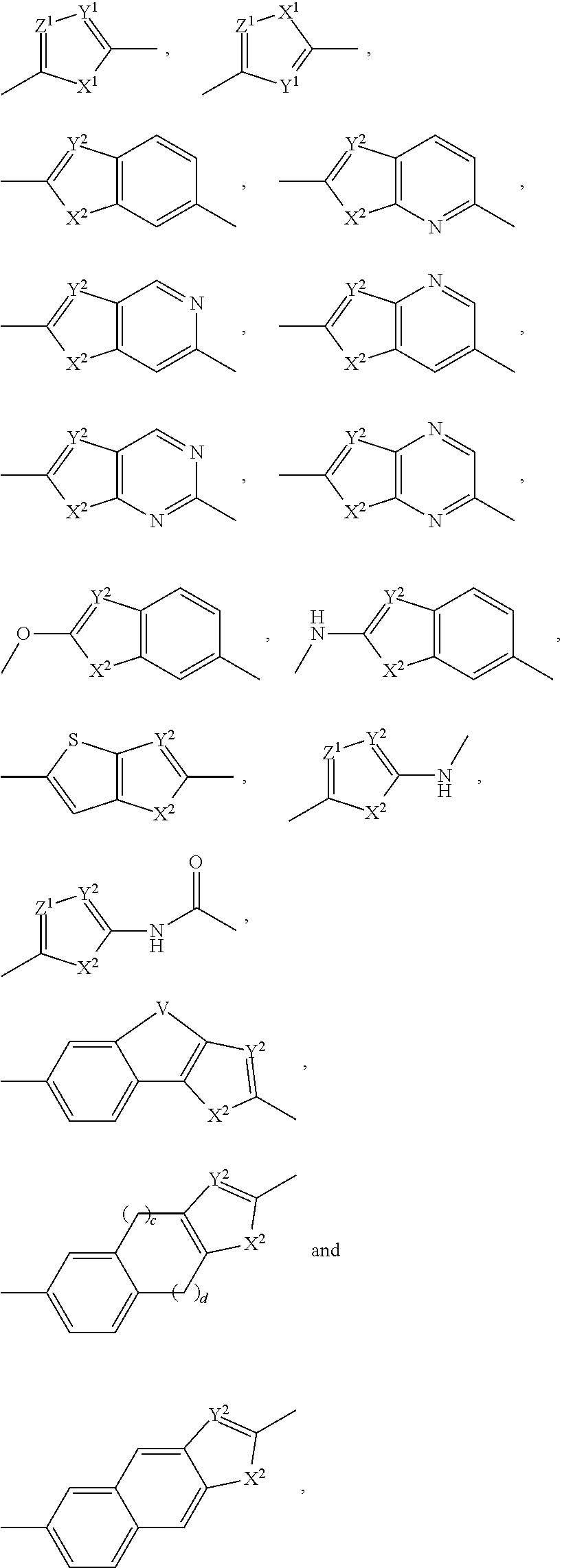Inhibitors of hcv ns5a
a technology of hcv and inhibitors, which is applied in the field of compounds useful for inhibiting the replication of hepatitis c virus (“ hcv”), can solve the problems of cumbersome treatment, serious health problems, and major worldwide causes of liver-related premature mortality
- Summary
- Abstract
- Description
- Claims
- Application Information
AI Technical Summary
Benefits of technology
Problems solved by technology
Method used
Image
Examples
example 1
General Synthesis
[0539]
[0540]Schemes 1-1 and 1-2 illustrate the various methods of preparing aryl-carbocyclic central scaffolds (Bs) and how the two ends of the molecule can be differentially constructed in order to allow for selective functionalization of either end of the molecule.
[0541]Scheme 1-3 outlines the preparation of core structures connected through a carbon-nitrogen bond. The nitrogen arylation is achieved using one of the several methods. In one embodiment, the acetophenone moiety and the V group in A-17 can be sequentially converted to a bromoketone as in A-18 for further introduction of the A-19 moiety. The coupling between A-15 and A-16 to A-17 represents a nucleophilic aromatic substitution method. Other methodologies employed include Buchwald or Ma couplings (J. Org. Chem. 2005, 70, 164), such as the coupling of A-15 with A-20 to B-6, A-15 with A-22 to B-7, A-21 with A-22 to B-8. When V is a carboxylate, it can be extended via an amide linkage. Taking B-6 as an exa...
example 2
Synthesis of Compounds of Formula IVb
[0551]Compounds of formula IVb can be made by schemes 2-1 and 2-2.
[0552]Step a. Referring to Scheme 2-3, compound 1 was prepared following procedures described in J. Med. Chem. 2007, 50, 6706.
[0553]Step b. A sample of compound 1 (1.0 g, 2.82 mmol) in dichloromethane was treated with excess 4N HCl in dioxane. At the completion of removal of Boc group as indicated by LCMS, solvents were removed and the residue was dried under vacuum. This material was taken up in acetonitrile (6 mL) and treated with tert-butyl (1H-pyrazol-1-yl)methylenedicarbamate (2) (1.01 g, 3.2 mmol) and DIPEA (0.60 g, 4.65 mmol) at rt overnight. The solvents were evaporated off and the crude product was purified by silica gel column chromatography with a gradient eluent consisting various ratio of EtOAc and hexanes to give compound 3 (0.59 g, 71% yield).
[0554]Step c. A solution of 3 (1.34 g, 2.69 mmol, from combined runs) in THF (5 mL) was treated with excess 4N HCl in dioxane ...
example 3
Synthesis of Compounds of Formula IX
[0586]Step a. Referring to Scheme 3-1, methyl 3-phenylcyclobutanecarboxylate A2 was obtained by treating a solution of 3-phenylcyclobutanecarboxylic acid (5.3 g, 30 mmol, Reference: JOC, 1962, 27, 1647) in methanol (50 mL) and thionyl chloride (2.9 mL, 39 mmol) first at 0° C. for 0.5 h and then at rt overnight. The solvent was removed, the residue was diluted with ethyl acetate (100 mL) and washed with brine and H2O, dried with Na2SO4. After removal of the solvent, the crude product was purified by silica gel column chromatography (n-hexane / ethyl acetate=10 / 1 (v / v)) to afford methyl 3-phenylcyclobutanecarboxylate (A2) (5.41 g, 95% yield).
[0587]Step b. To a solution of methyl 3-phenylcyclobutanecarboxylate (A2) (5.41 g, 28 mmol) and AlCl3 (9.5 g, 71 mmol) in methylene chloride (150 mL) at 0° C. was added acetyl chloride (4 mL) dropwise and the reaction mixture was stirred at rt overnight. The reaction mixture was diluted with 1N HCl (100 mL) and ex...
PUM
| Property | Measurement | Unit |
|---|---|---|
| volume | aaaaa | aaaaa |
| pH | aaaaa | aaaaa |
| pharmaceutical composition | aaaaa | aaaaa |
Abstract
Description
Claims
Application Information
 Login to View More
Login to View More - R&D
- Intellectual Property
- Life Sciences
- Materials
- Tech Scout
- Unparalleled Data Quality
- Higher Quality Content
- 60% Fewer Hallucinations
Browse by: Latest US Patents, China's latest patents, Technical Efficacy Thesaurus, Application Domain, Technology Topic, Popular Technical Reports.
© 2025 PatSnap. All rights reserved.Legal|Privacy policy|Modern Slavery Act Transparency Statement|Sitemap|About US| Contact US: help@patsnap.com



